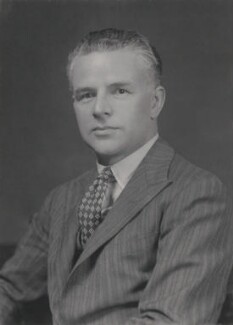Harold Munro Fox facts for kids
Quick facts for kids
Professor
Harold Munro Fox
|
|
|---|---|

Portrait by Walter Stoneman, 1937
|
|
| Born |
Harold Munro Fuchs
28 September 1889 Clapham, London, England
|
| Died | 29 January 1967 (aged 77) London, England
|
| Education | Brighton College |
| Alma mater | Gonville and Caius College, Cambridge |
| Occupation | Zoologist |
| Employer |
See list
Marine Biological Association
(1911–1912, 1919) Stazione Zoologica
(1912–1913) Royal College of Science
(1913–1914, 1919) Royal Army Service Corps
(1914–1918) Cairo School of Medicine
(1919–1923) Gonville and Caius College
(1923–1927?) Birmingham University
(1927–1941) Bedford College, London
(1941–1954) |
| Title | Fullerian Professor of Physiology (1953–1957) |
| Spouse(s) |
Léonie Thérèse Roger
(m. 1917, divorced)Natalia "Natasha" Lvovna
(m. 1931) |
| Relatives | Alison Settle (sister) |
| Awards |
|
Harold Munro Fox (born Fuchs; September 28, 1889 – January 29, 1967) was an important English zoologist. Zoologists are scientists who study animals. He was known for his research on tiny sea creatures and for teaching at universities.
Contents
Early Life and Education
Harold Munro Fox was born Harold Munro Fuchs in Clapham, London, in 1889. His father was George Gotthilf Fuchs, and his mother was Margaret Isabella Campbell Munro. His parents separated when he was young.
Harold went to Brighton College for his schooling. Later, he studied at Gonville and Caius College, Cambridge, from 1908 to 1911. There, he focused on natural sciences, which includes subjects like biology, chemistry, and physics.
A Career in Zoology
After finishing college, Harold Fox began his work as a zoologist.
Early Research and Travel
From 1911 to 1912, he worked at the Marine Biological Association of the United Kingdom in Plymouth. He studied the genes of sea urchins with other scientists. In 1912, he traveled to Naples, Italy, where he spent ten months researching how sea creatures reproduce at the Stazione Zoologica. In 1913, he became a lecturer in zoology at the Royal College of Science in London.
World War I and Name Change
When World War I started, Harold joined the Royal Army Service Corps. He served in places like the Balkans, Egypt, and Palestine. During this time, he officially changed his last name from Fuchs to Fox. In 1917, he married Léonie Thérèse Roger in Egypt.
After the war, Fox returned to London. He also worked again at the Marine Biological Association. In 1919, he went to Cairo, Egypt, to teach at the Cairo School of Medicine. While there, he completed a research paper on tiny organisms called Bodo. This research helped him become a fellow at Gonville and Caius College, Cambridge in 1920, a position he took up in 1923.
Expeditions and University Roles
In Cambridge, Harold Fox and John Stanley Gardiner led an expedition. From 1924 to 1925, they studied the animals living in the Suez Canal.
In 1927, Fox became the head of the Zoology Department at the University of Birmingham. He held this important role until 1941. During this time, his first marriage ended. In 1931, he married his second wife, Natalia 'Natasha' Lvovna.
From 1941 to 1954, he was a Professor of Zoology at Bedford College, London. Because of World War II, the college moved from London to Cambridge. This allowed him to work closely with his old colleagues from Gonville and Caius College again.
Later Years and Achievements
After retiring, Professor Fox continued his research. He moved to Queen Mary College, London, as a research associate. He focused on studying marine invertebrates, which are animals without backbones, such as tiny crustacea called ostracods.
Harold Munro Fox was recognized for his important scientific work. He became a Fellow of the Royal Society in 1937. This is a very high honor for scientists in the United Kingdom. In 1966, he received the Darwin Medal, another prestigious award for his contributions to biology.
Harold Munro Fox passed away in London on January 29, 1967.

